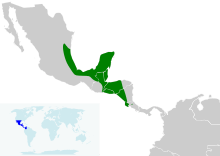Melodious blackbird
| Melodious blackbird | |
|---|---|
 | |
| In Belize | |
| Scientific classification | |
| Kingdom: | Animalia |
| Phylum: | Chordata |
| Class: | Aves |
| Order: | Passeriformes |
| Family: | Icteridae |
| Genus: | Dives |
| Species: | D. dives |
| Binomial name | |
| Dives dives (Deppe, 1830) | |
 | |
| Range of D. dives | |
The melodious blackbird (Dives dives) is a New World tropical icterid bird. It is a resident breeder from coastal eastern and south-eastern Mexico to Costa Rica. Its range is expanding. El Salvador was colonised in the 1950s, and eastern Guatemala in the 1960s. Prior to 1989 there was only one Costa Rican record, but it is now easily seen at least as far south as San José, and it is expected to colonise Panama.
The adult melodious blackbird is a medium-sized blackbird with a rounded tail. The male is 25.5 cm (10.0 in) long and weighs 108 g (3.8 oz). The slightly smaller female is 23 cm (9.1 in) long and weighs 95 g (3.4 oz). The adult plumage is entirely black with a bluish gloss, and the bill legs and feet are also black. The iris is brown. Females are identically plumaged to the males, but young birds are brownish black and lack iridescence. There are no subspecies.
The song is a duet between pairs, with a see note, followed by a whit and a northern cardinal-like whistle. The call is a metallic puitt.
The melodious blackbird inhabits a wide range of habitats, but avoids dense forest and thick undergrowth. It has adapted to human habitation and can be seen in gardens and on lawns. The melodious blackbird forages mainly on the ground for insects but will also take nectar and ripening maize ears as well as other plants, such as the fruits of the gumbo-limbo (Bursera simaruba) and Trophis racemosa (Moraceae).[2]
Breeding birds are highly territorial, and adults will attack predators like the brown jay, but small flocks form outside the nesting season. A breeding pair will give a display in which each bird spreads its tail, extends its wings, and ruffles its plumage.
Both sexes build a cup nest of plant material 3–7 m (9.8–23.0 ft) high in a bush or tree and line it with mud and dung. The female lays three or four brown-blotched blue eggs, which she incubates alone, although the male helps with feeding the chicks. This species is not known to be parasitised by cowbirds, which presumably has also contributed to its success.
This species has benefited from deforestation, which has allowed its rapid range expansion through creation of suitable habitat.
References
- ↑ BirdLife International (2012). "Dives dives". IUCN Red List of Threatened Species. Version 2013.2. International Union for Conservation of Nature. Retrieved 26 November 2013.
- ↑ Foster, Mercedes S. (2007): The potential of fruiting trees to enhance converted habitats for migrating birds in southern Mexico. Bird Conservation International 17(1): 45-61. doi:10.1017/S0959270906000554 PDF fulltext
- Jaramillo, Alvaro & Burke, Peter (1999): New World Blackbirds. Christopher Helm, London. ISBN 0-7136-4333-1
- Stiles, F. Gary & Skutch, Alexander Frank (1989): A guide to the birds of Costa Rica. Comistock, Ithaca. ISBN 0-8014-9600-4
External links
| Wikimedia Commons has media related to Dives dives. |
| Wikispecies has information related to: Dives dives |
- "Melodious blackbird media". Internet Bird Collection.
- Melodious blackbird photo gallery at VIREO (Drexel University)
- Photo and article at birdguatemala.org
- Melodious blackbird species account at NeotropicalBirds (Cornell University)
